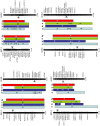Comparative genome analysis between Agrostis stolonifera and members of the Pooideae subfamily, including Brachypodium distachyon
- PMID: 24244501
- PMCID: PMC3823605
- DOI: 10.1371/journal.pone.0079425
Comparative genome analysis between Agrostis stolonifera and members of the Pooideae subfamily, including Brachypodium distachyon
Abstract
Creeping bentgrass (Agrostis stolonifera, allotetraploid 2n = 4x = 28) is one of the major cool-season turfgrasses. It is widely used on golf courses due to its tolerance to low mowing and aggressive growth habit. In this study, we investigated genome relationships of creeping bentgrass relative to the Triticeae (a consensus map of Triticum aestivum, T. tauschii, Hordeum vulgare, and H. spontaneum), oat, rice, and ryegrass maps using a common set of 229 EST-RFLP markers. The genome comparisons based on the RFLP markers revealed large-scale chromosomal rearrangements on different numbers of linkage groups (LGs) of creeping bentgrass relative to the Triticeae (3 LGs), oat (4 LGs), and rice (8 LGs). However, we detected no chromosomal rearrangement between creeping bentgrass and ryegrass, suggesting that these recently domesticated species might be closely related, despite their memberships to different Pooideae tribes. In addition, the genome of creeping bentgrass was compared with the complete genome sequence of Brachypodium distachyon in Pooideae subfamily using both sequences of the above-mentioned mapped EST-RFLP markers and sequences of 8,470 publicly available A. stolonifera ESTs (AgEST). We discovered large-scale chromosomal rearrangements on six LGs of creeping bentgrass relative to B. distachyon. Also, a total of 24 syntenic blocks based on 678 orthologus loci were identified between these two grass species. The EST orthologs can be utilized in further comparative mapping of Pooideae species. These results will be useful for genetic improvement of Agrostis species and will provide a better understanding of evolution within Pooideae species.
Conflict of interest statement
Figures






Similar articles
-
Linkage map construction in allotetraploid creeping bentgrass (Agrostis stolonifera L.).Theor Appl Genet. 2005 Aug;111(4):795-803. doi: 10.1007/s00122-005-2065-x. Epub 2005 Jun 25. Theor Appl Genet. 2005. PMID: 15981010
-
Complete chloroplast genome sequences of Hordeum vulgare, Sorghum bicolor and Agrostis stolonifera, and comparative analyses with other grass genomes.Theor Appl Genet. 2007 Aug;115(4):571-90. doi: 10.1007/s00122-007-0567-4. Epub 2007 May 30. Theor Appl Genet. 2007. PMID: 17534593 Free PMC article.
-
Analysis of EST sequences suggests recent origin of allotetraploid colonial and creeping bentgrasses.Mol Genet Genomics. 2007 Aug;278(2):197-209. doi: 10.1007/s00438-007-0240-2. Epub 2007 May 12. Mol Genet Genomics. 2007. PMID: 17497174
-
Unlocking Triticeae genomics to sustainably feed the future.Plant Cell Physiol. 2013 Dec;54(12):1931-50. doi: 10.1093/pcp/pct163. Epub 2013 Nov 6. Plant Cell Physiol. 2013. PMID: 24204022 Free PMC article. Review.
-
Brachypodium: A Monocot Grass Model Genus for Plant Biology.Plant Cell. 2018 Aug;30(8):1673-1694. doi: 10.1105/tpc.18.00083. Epub 2018 Jul 11. Plant Cell. 2018. PMID: 29997238 Free PMC article. Review.
Cited by
-
Complete mitochondrial genome of Agrostis stolonifera: insights into structure, Codon usage, repeats, and RNA editing.BMC Genomics. 2023 Aug 18;24(1):466. doi: 10.1186/s12864-023-09573-1. BMC Genomics. 2023. PMID: 37596544 Free PMC article.
-
Transcriptome analysis of creeping bentgrass exposed to drought stress and polyamine treatment.PLoS One. 2017 Apr 26;12(4):e0175848. doi: 10.1371/journal.pone.0175848. eCollection 2017. PLoS One. 2017. PMID: 28445484 Free PMC article.
References
-
- Tang H, Bowers JE, Wang X, Ming R, Alam M, et al. (2008) Synteny and collinearity in plant genomes. Science 320: 486–488. - PubMed
-
- Renvoize SA, Clayton WD (1992) Classification and evolution of the grasses. In G.P. Chapman [ed.]), 3–37. Grass evolution and domestication. Cambridge University Press, Cambridge, UK.
-
- Watson L, Dallwitz MJ (1992) The grass genera of the world. pp1038 CAB International, Wallingford.
Publication types
MeSH terms
LinkOut - more resources
Full Text Sources
Other Literature Sources
Research Materials

